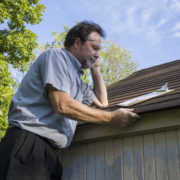Five Reasons You Should Get Your Roof Inspected… Before It’s Too Late!
A leaky roof can cause some serious damage to a building. Not only will the building be affected, but businesses sometimes have to shut down temporarily if the leaking is bad enough. The bad thing is once you notice a leaking roof, it’s too little too late. It usually takes a long time for roof moisture to become visible to the naked eye, which is why a frequent commercial roof inspection is critical. Not convinced? Here are several things that could happen if you don’t get your roof inspected often enough.
1. Mold and Mildew Health Concerns
When you have roof moisture, mold and mildew will begin to grow. As the temperature heats up and cools down, it will only continue to grow and become more harmful. The worst possible scenario is the mold moving toward air ducts where everyone will be breathing it in. Infrared roof inspections can detect areas where mold and mildew are susceptible to growing. This way you can fix the issue before the growth occurs.
2. Wasted Energy
If your roof is leaking, chances are there are holes in the insulation, drywall and everywhere in between. This gives your interior hot or cool air the chance to escape, leading to higher energy bills. An infrared thermography inspection can see weak spots in a roof where air could be leaking out.
3. Fire Hazards
Everyone knows electricity and water don’t mix. If nothing else, a commercial roof inspection needs to be done often enough so you can rest easy knowing water won’t be entering your building and dripping on electrical equipment.
4. Interior Damage Potential
Even the smallest leak in your roof could cause some serious damage. You could experience ceiling tiles or drywall peeling off and falling if a water leak doesn’t get fixed soon enough. Not only will you be putting your inventory at risk, but you’ll also be putting your employees and potential customers in danger as well. You can avoid all this possible damage by simply scheduling a commercial roof inspection on a regular basis.
5. Roof Deterioration
From a cost perspective, there’s nothing that can hurt a business’ finances than having to replace a roof unexpectedly. Roofs aren’t going to last forever, but with a regular infrared thermography inspection, you can extend its lifespan. Standing water is the biggest reason why a roof fails, but there are plenty of other reasons as well.
At Infrared Consulting Services, we have over 30 years of experience providing commercial customers with the highest quality roof inspections. You never know when disaster can strike your business, but we are here to help make it a little more predictable. Don’t wait to get your roof inspected. Be sure to contact us today.





 By detecting problems before they occur and by pin-pointing exactly where problems might exist, Infrared Thermographic Testing has many benefits.
By detecting problems before they occur and by pin-pointing exactly where problems might exist, Infrared Thermographic Testing has many benefits.
 Learn more about our wide range of non-invasive, non-destructive inspection & testing services and if they are right for your needs.
Learn more about our wide range of non-invasive, non-destructive inspection & testing services and if they are right for your needs.
 Founded in 1988, Infrared Consulting Services (ICS) provides professional infrared electrical, NDT and building envelope inspection services nationwide.
Founded in 1988, Infrared Consulting Services (ICS) provides professional infrared electrical, NDT and building envelope inspection services nationwide.